Abstract
Candida albicans, an opportunistic fungal pathogen, frequently colonizes immune-compromised patients and causes mild to severe systemic reactions. Only few antifungal drugs are currently in use for therapeutic treatment. However, evolution of a drug-resistant C. albicans fungal pathogen is of major concern in the treatment of patients, hence the clinical need for novel drug design and development. In this study, in vitro screening of novel putative pyrrolo[1,2-a]quinoline derivatives as the lead drug targets and in silico prediction of the binding potential of these lead molecules against C. albicans pathogenic proteins, such as secreted aspartic protease 3 (SAP3; 2H6T), surface protein β-glucanase (3N9K) and sterol 14-alpha demethylase (5TZ1), were carried out by molecular docking analyses. Further, biological activity-based QSAR and theoretical pharmacokinetic analysis were analyzed. Here, in vitro screening of novel analogue derivatives as drug targets against C. albicans showed inhibitory potential in the concentration of 0.4 µg for BQ-06, 07 and 08, 0.8 µg for BQ-01, 03, and 05, 1.6 µg for BQ-04 and 12.5 µg for BQ-02 in comparison to the standard antifungal drug fluconazole in the concentration of 30 µg. Further, in silico analysis of BQ-01, 03, 05 and 07 analogues docked on chimeric 2H6T, 3N9K and 5TZ1 revealed that these analogues show potential binding affinity, which is different from the therapeutic antifungal drug fluconazole. In addition, these molecules possess good drug-like properties based on the determination of conceptual Density Functional Theory (DFT)-based descriptors, QSAR and pharmacokinetics. Thus, the study offers significant insight into employing pyrrolo[1,2-a]quinoline analogues as novel antifungal agents against C. albicans that warrants further investigation.
1. Introduction
Globally, Candida albicans (C. albicans) is a genus of yeast that frequently causes nosocomial fungal infection in patients with a defined clinical condition—i.e., invasive candidiasis and candidemia [1,2]. Being an opportunistic fungal pathogen, C. albicans asymptomatically colonized mucosal surfaces of the skin, vagina, mouth, and intestine in patients suffering from invasive candidiasis as well as systemically colonizes the bloodstream in candidemia patients and poses a major therapeutic challenge in medically and immune-compromised patients, with a mortality rate of 30–40% [3,4,5,6]. Further, C. albicans frequently infects humans with pre-existing conditions due to overuse of broad-spectrum antibiotics and immunosuppressants, surgical intervention, diabetes, prolonged hospitalization, and radio- as well as chemotherapy (in case of malignancy) [7,8]. Until now, reports suggested that only few classes of potential antifungal drugs such as azoles, echinocandins, and polyenes are on demand for the treatment of fungal infections and that multidrug resistance fungal pathogens are increasing worldwide along with adverse as well as cytotoxic effects [9,10,11].
The innate immune response predominates in regulating C. albicans fungal infectivity in normal individuals [12]. However, in the state of immune dysfunction, fungus invasion results due to switching of yeast to hyphal growth formations, which enter the human body via pathogen recognition factors present on various immune cells, which induces immune reactivity causing a wide range of symptoms from superficial to major life-threatening systemic reactions [3]. However, the number of antifungal drugs in treatment are very limited [13] and therefore, new therapies for fungal infection are of public concern as drug-resistant C. albicans are increasing worldwide [9,14,15].
However, in organic chemistry, the maximum heterocyclic compounds possess significant biological activity [16,17,18,19,20,21,22,23,24,25,26,27,28,29,30,31,32,33,34,35,36]. Recent reports suggest that indolizine is a very attractive molecule among the heterocyclic compounds and possesses two fused ring structures with carbon and nitrogen bridging atoms. Further, the numerous indolizine derivatives show potential biological activities [16,21,22,23,24,25,26,27,28,29,30,31,32,33,34,35,36,37,38,39,40,41], which includes antioxidant [42,43,44], antimicrobial [42,43,44,45,46], anti-inflammatory [47], anticancer [48,49] and antituberculosis [50] activities.
Pyrrolo[1,2-a]quinoline and pyrrolo[1,2-a]isoquinoline are family members of indolizine that are also known as 5,6-benzo-fused indolizine and 7,8-benzo-fused indolizine, respectively [51]. The series of these analogues has shown remarkable biological activity so far [52]. For instance, recent publications from V. Uppar et al. (2020) and others shows that pyrrolo[1,2-a]quinoline derivatives effectively inhibit the activity of microbial pathogens such as bacteria (both Gram-positive and Gram-negative) [44,53,54,55,56], and fungus [57], followed by various disease conditions such as cancer [58], malaria [59], inflammation [60] and Alzheimer disease [61]. In addition, these derivatives possess antioxidant activity [44,54,55,56]. Further, ethyl-1-(subbenzoyl)-5-methylpyrrolo[1,2-a]quinoline-3-carboxylate and dimethyl 1-(subbenzoyl)-5-methylpyrrolo[1,2-a]quinoline-2,3-dicarboxylate derivatives have been tested for their larvicidal activity against Anopheles arabiensis [56]. Collectively, the broad-spectrum nature of the compounds intensified further to investigate whether newly synthesized derivatives target C. albicans fungal pathogens. Herein, the synthesized dimethyl-4-bromo-1-(4-substituted benzoyl) pyrrolo[1,2-a]quinoline-2,3-dicarboxylate methyl 4-bromo-1-(4-sub-benzoyl)pyrrolo[1,2-a]quinoline-3-carboxylate 1a-n (Scheme 1) [55], a novel analogue derivative (Figure 1), was tested for its inhibitory activity against C. albicans in vitro. As shown in Figure 1, these derivatives consist of methyl ester groups present at the second and third positions (highlighted) of BQ-01, 03, 05 and 07, and only one ester group at the third position of BQ-02, 04, 06 and 08.
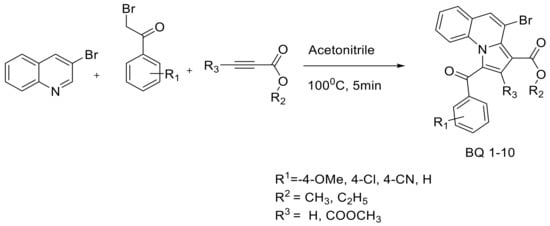
Scheme 1.
Synthetic scheme for the construction of dimethyl-4-bromo-1-(substituted benzoyl)pyrrolo[1,2-a]quinoline-2,3-dicarboxylate [44].
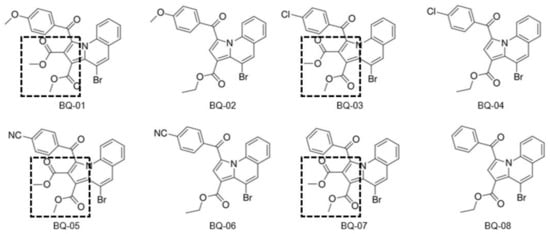
Figure 1.
Molecular structures and codes of pyrrolo[1,2-a]quinoline derivatives used for their in vitro antifungal activity [44]. All the eight pyrrolo[1,2-a]quinoline derivatives possess common bromo substituents at the fourth position. The four compounds, namely, BQ-01, 03, 05 and 07, consist of methyl ester groups at the second and third positions; in comparison, BQ-02, 04, 06 and 08 possess hydrogen groups at the second position and ethyl esters at third position, respectively. Further, BQ-01, 03, 05 and 07 consist of two ester groups at second and third positions (as highlighted), which donate two electrons, and only one electron donor group present at the third positions of the BQ-02, 04, 06 and 08 derivatives.
Furthermore, chemoinformatic methods are utilized for the study and organization of chemical information, a tool widely used for the development of new medical drugs in the pharmaceutical industry. Here, chemoinformatics are applied for the prediction of the molecular properties of many systems based on the knowledge of previously studied molecular structures and computational displaying of the same by considering the close relationship between biological data and organic structures and energies. The literature suggests that the molecular descriptors can be related to molecular properties [62].
In the present study, compounds tested in vitro were anaylzed to elucidate their mechanisms of action by employing in silico molecular docking calculations. In addition, the present work reports the information on the chemical reactivity of the molecules under study through Density Functional Theory (DFT) derived concepts, which shows correlation of their biological activity [63,64,65,66,67,68,69]. Further, the chemical reactivity properties of these molecules were further analyzed using global and local descriptors by extracting the information about their biological reactivity for designing new medical drugs [70,71,72,73,74].
2. Results and Discussion
2.1. Analysis of MIC against C. albicans
The inhibitory potential of pyrrolo [1, 2-a]quinoline derivatives targeted against C. albicans were observed after 24 h of incubation. The derivatives BQ-06, 07 and 08 show the highest minimum inhibitory concentrations (MICs) at 0.4 µg/mL, whereas BQ-01, 03, and 05 have MICs of 0.8 µg/mL. Further, the BQ-04 derivative possesses an MIC of 1.6 µg/mL, followed by BQ-12 which causes inhibition of growth of C. albicans at 12.5 µg/mL (Table 1).

Table 1.
Minimum inhibitory concentration of pyrrolo[1,2-a]quinoline derivatives against C. albicans.
2.2. Molecular Docking
Binding orientation of pyrrolo[1,2-a] quinoline on target proteins 2H6T, 3N9K and 5TZ1 from C albicans were assessed by molecular docking analysis. Out of the eight pyrrolo[1, 2-a] quinoline derivatives, BQ-01, 03, 05, and 07 were used for molecular docking analysis. These molecules possess common methyl ester groups at the second and third positions. However, BQ-02, 04, 06 and 08 consist of a common hydrogen group at the second position and ethyl ester at third position. The results obtained for docking between the macromolecule and ligand show eight poses of the ligand molecule that is docked at the macromolecule (protein). The confirmation of pose consisting of the least binding affinity was saved in .pdb format and their interactions were studied using Pymol software (The PyMOL Molecular Graphics System, Version 2.0 Scrödinger, LLC). The amino acid pocket residues of the macromolecule interaction with the ligand were analyzed for the bonded (H-bonds) and nonbonded interactions (hydrophobic interactions) and were later visualized by using Pymol software. The formation of the number of hydrogen bonds (H-bonds) forming amino acid residues and binding free energy of the interaction between protein targets and ligands obtained are shown in Table 2. Further, the number of hydrogen bonds formed were identified for the ligand molecules BQ-03, BQ-05, and BQ-07 (6, 5, and 6 hydrogen bonds, respectively) against C. albicans protein 2H6T, which shows a stronger binding interaction than the drug candidate (four hydrogen bonds). The H-bond forming amino acid residues between the ligand molecules BQ-01, 03, 05, and 07 and the protein target 2H6T were identified as THR-221 and THR-222. Further, BQ-03 and 05 also actively interact with THR-221 and THR-222 along with GLY-220, whereas BQ-07 interacts with THR-221 and THR-222 along with VAL-12. Moreover, these molecules exhibit potential binding affinity to the amino acid residues, which possess different interaction sites compared to that of the therapeutic antifungal drug fluconazole. However, in the cases of C. albicans proteins 3N9K and 5TZ1, the number of hydrogen bonds formed with the ligands were less than or equal to fluconazole. Interestingly, the H-bond forming amino acid residues identified by the interaction analyses were different from that of fluconazole, which indicates novel binding interaction of the ligand molecules to the macromolecular target. These results offers pyrrolo[1,2-a]quinoline analogues as putative novel targets against drug-resistant C. albicans fungal pathogens.

Table 2.
The details of the H-bond formation and binding free energy.
Further, the ligands and macromolecular targets (3N9K and 5TZ1) possess stronger binding free energy than fluconazole, as shown in Table 2. Among the tested ligands, BQ-03 shows binding free energies of −7.4, −9.7 and −9.1 kcal/mol against 2H6T, 3N9K and 5TZ1, respectively. The binding interaction between target proteins 3N9K and 5TZ1 and all the tested ligands (BQ-01, BQ-03, BQ-05, and BQ-07) showed ∆G values that are higher than fluconazole and it reveals that these compounds possess a stronger affinity towards the protein targets 3N9K and 5TZ1 than the drug, indicating that the interaction between the ligand molecule and the protein is possible and thermodynamically favorable. Further, a high number of hydrogen bonds were formed with ligand-2H6T interactions; however, strong binding affinity in terms of binding free energy was observed with ligand-3N9K, and ligand-5TZ1 interactions. These results show the presence of nonbonded interactions along with hydrogen bonds in ligand-3N9K and ligand-5TZ1 interactions. The strong binding interaction of ligands BQ-01, 03, 05, and 07, compared to fluconazole, to protein targets 3N9K and 5TZ1, are a good platform for further development of a novel drug target against C albicans. The free energy change upon binding of protein–ligand interaction has been shown as follows:
Fluconazole interacted with 2H6T with a binding affinity of −7.5 kcal/mol, while it showed −7.8 and −7.2 kcal/mol binding energy when interacting with 3N9K and 5TZ1, respectively.
The BQ-01 ligand interacted with 2H6T with a binding affinity of −6.5 (kcal/mol), while it showed −9.4 (kcal/mol) and −8.9 (kcal/mol) binding energies when interacting with 3N9K and 5TZ1, respectively.
The BQ-03 ligand interacted with 2H6T with a binding affinity of −7.4 (kcal/mol), while it showed −9.7 (kcal/mol) and −9.1 (kcal/mol) binding energies when interacting with 3N9K and 5TZ1, respectively.
The BQ-05 ligand interacted with 2H6T with a binding affinity of −7.2 (kcal/mol), while it showed −9.4 (kcal/mol) and −8.6 (kcal/mol) binding energies when interacting with 3N9K and 5TZ1, respectively.
The BQ-07 ligand interacted with 2H6T with a binding affinity of −6.8 (kcal/mol), while it showed −9.2 (kcal/mol) and −8.7 (kcal/mol) binding energies when interacting with 3N9K and 5TZ1, respectively.
Further, the docking result confirms that the drug fluconazole (Figure 2) or ligand molecules BQ-01 (Figure 3), 03 (Figure 4), 05 (Figure 5) and 07 (Figure 6) were held in the active pocket of the C. albicans fungal proteins 2H6T, 3N9K or 5TZ1, respectively.
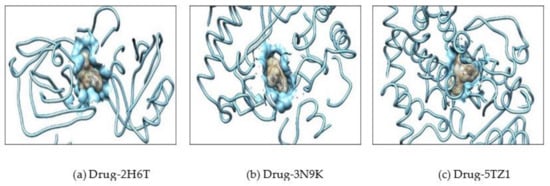
Figure 2.
Showing interaction of the drug (fluconazole) molecule which completely fit into the hydrophobic pocket of the C. albicans fungal proteins—(a) 2H6T, (b) 3N9K and (c) 5TZ1.
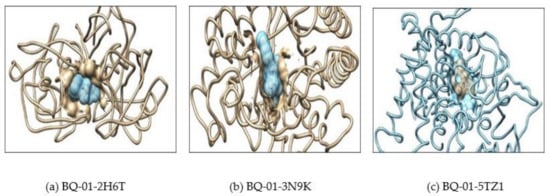
Figure 3.
(a) Showing interaction of the BQ-01 molecule which completely fit into the hydrophobic pocket of the C. albicans fungal proteins—2H6T, (b) 3N9K and (c) 5TZ1.
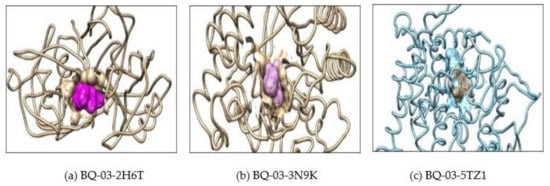
Figure 4.
Showing interaction of the BQ-03 molecule which completely fit into the hydrophobic pocket of the C. albicans fungal proteins—(a) 2H6T, (b) 3N9K and (c) 5TZ1.
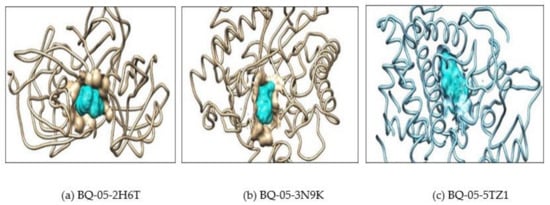
Figure 5.
Showing interaction of the BQ-05 molecule which completely fit into the hydrophobic pocket of the C. albicans fungal proteins—(a) 2H6T, (b) 3N9K and (c) 5TZ1.

Figure 6.
Showing interaction of the BQ-07 molecule which completely fit into the hydrophobic pocket of the C. albicans fungal protein—(a) 2H6T, (b) 3N9K and (c) 5TZ1.
2.3. Determination of the Conceptual DFT Reactivity Descriptors of the Molecules and their Related Pharmacokinetics
The determination of conformers of the molecules considered in the current study was performed by utilizing various software described elsewhere, as described in Section 3.5 [75,76,77,78,79,80,81,82,83,84,85,86,87,88,89,90,91]. Further, the results obtained from the model chemistry consider the MN12SX screened-exchange density function [81] together with the Def2TZVP basis set [82,83], and in all cases the charge of the molecules was equal to zero while the radical anion and cation were considered in the doublet spin state.
Further, assumption of the goodness of a given density functional can be estimated by comparing the results with the experimental values that are being reproduced or with the results that can be obtained through post Hartree–Fock calculations such as MP2, MP4 or CCSD. However, this is not always possible due to the lack of experimental results for the molecular systems that are being studied or the large size of the molecules that keep some accurate methodologies computationally practical. For this reason, we have developed a protocol named Koopmans in DFT (KID) [92,93,94], which is an attempt to validate a given density functional in terms of its internal coherence. Within the KID protocol, four descriptors have been defined where it has been shown that there is a connection between those descriptors and the simplest conformity to the theorem of Koopmans or the Ionization Energy theorem, which is its equivalent within the Generalized Kohn–Sham (GKS) version of DFT, by connecting the electronic energy of the Highest Occupied Molecular Orbital (HOMO)—that is, —with the negative if the ionization energy, I, and the electronic energy of the Lowest Unoccupied Molecular Orbital (LUMO)—that is —with the negative of the Electron affinity, A, giving rise to , , and , where , and represents the ground state energy of the neutral molecule, of the radical cation and the radical anion, respectively, in the geometry of the neutral molecule. An additional descriptor, ∆SL, was designed [92,93,94] to help in the verification of the accuracy of the KID approximation by comparing the HOMO energy of the radical anion with the energy of the LUMO of the neutral species. Although the Koopmans complaint behavior of the MN12SX density functional has been proven previously for the case of peptides [92,93,94], we think that it is worth performing a further validation for the case of the molecules considered in the present study.
As we have shown in our previous research [85,86,87,88,89,90,95], the KID procedure is also valid in the presence of water as the solvent and represents an advantage over the use of the vertical I and A for the calculation of the global descriptors because it avoids the separate calculation of the radical cation and anion which could be difficult for molecules of the size considered here. It has been shown by Frau and Glossman-Mitnik [69,84,85,86,87,88,89,90,95] that the HOMO and LUMO energies obtained with the MN12SX/Def2TZVP/H2O model chemistry allow the verification of the KID procedure—that is, rendering an approximate Koopmans behavior. All the calculated molecules are neutral—that is, they have a charge equal to zero—and these optimized structures were considered for the estimation of the energies of the cation and anion radicals because the definitions of the conceptual DFT descriptors have been derived at constant external potential [72,73,74,96,97].
The HOMO, LUMO and Singly Occupied Molecular Orbital (SOMO, which is equivalent to the HOMO of the radical anion) orbital energies, HOMO–LUMO gap and the KID descriptors (all in eV) tested in the verification of the Koopmans-like behavior of the MN12SX density functional for the new BQ molecules are shown in Table 3, while the calculated values for these global reactivity descriptors using the MN12SX/Def2TZVP/H2O model chemistry and the KID procedure are displayed in Table 4.

Table 3.
Highest Occupied Molecular Orbital (HOMO), Lowest Unoccupied Molecular Orbital (LUMO) and Singly Occupied Molecular Orbital (SOMO) orbital energies, HOMO–LUMO gap and the Koopmans in DFT (KID) descriptors (all in eV) tested in the verification of the Koopmans-like behavior of the MN12SX density functional for the new BQ molecules.

Table 4.
Global reactivity descriptors for the new BQ molecules: electronegativity (χ), hardness (η), electrophilicity (ω) (all in eV), softness S (in eV−1), nucleophilicity N, electrodonating Power (ω−), electroaccepting Power (ω+) and net electrophilicity () (also in eV).
It can be seen from the results in Table 1 that the descriptors considered for the estimation of the goodness of the selected density functional through the KID procedure are very close to zero for all the studied molecules, providing an accurate justification for the choice of the MN12SX/Def2DZVP/H2O model chemistry employed for the computational determinations in this study.
As a complement to these global reactivity descriptors that arise from conceptual DFT, Domingo and his collaborators [98] proposed a nucleophilicity index (N) (not to be confused with the number of electrons) through the consideration of the HOMO energy obtained through the KS scheme with an arbitrary shift of the origin taking the molecule of tetracyanoethylene (TCE) as a reference. On the basis of the previous definition and the scale established by these authors [98], and the results presented in Table 4, it can be concluded that all the molecules considered in this study can be regarded as moderate nucleophiles.
Next, QSAR analysis was carried out on the molecular properties of the new BQ molecules, such as ∆G of solvation, molecular weight, Log P, total polar surface area (TPSA), and molecular volume, using Molinspiration software. The predicted parameters are shown in Table 5.

Table 5.
Predicted parameters useful for QSAR analyses for the new BQ molecules: ∆G of solvation (in Kcal/mol), Molecular Weight (MW), Partition Coeffcient (logP), Total Polar Surface Area (TPSA) () and Molecular Volume ().
The results presented in Table 5 can be better understood if a graphical representation of these physicochemical properties displays in the form of what is known as a bioavailability radar, where six physicochemical properties are considered: lipophilicity, size, polarity, solubility, flexibility, and saturation. Each descriptor must fall entirely within the physicochemical range depicted in the pink area of the radar plot of the molecule to be considered drug-like. These results are presented in Figure 7.

Figure 7.
Bioactivity radars of the (a) BQ-01, (b) BQ-02, (c) BQ-03, (d) BQ-04, (e) BQ-05, (f) BQ-06, (g) BQ-07, and (h) BQ-08 molecules.
Next, a web tool known as SwissTargetPrediction for efficient prediction of protein targets of small molecules was considered for the determination of the potential bioactivity of the molecules considered in this study [99]. The associated website allows the estimation of the most probable macromolecular targets of a small molecule assumed as bioactive. The prediction confirms that a combination of 2D and 3D similarity with a library of 370,000 known actives on more than 3000 proteins from three different species, as shown in Figure 8.
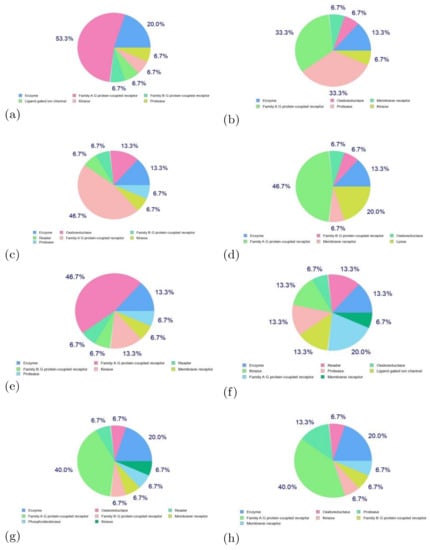
Figure 8.
Predicted biological targets of the (a) BQ-01, (b) BQ-02, (c) BQ-03, (d) BQ-04, (e) BQ-05, (f) BQ-06, (g) BQ-07, and (h) BQ-08 molecules.
During the development process of a new drug, it is very important to know the possible fate of a therapeutic compound in an organism, a process that is known as pharmacokinetics. This can be achieved by analyzing the associated effects in the form of individual indices that involve Absorption, Distribution, Metabolism, and Excretion (ADME) parameters. These parameters can be obtained by using computer models that can be alternatives to the experimental procedures for their determination. In this work, some ADME parameters were estimated with the aid of the SwissADME software that is available online [100], and the results are presented in Table 6.

Table 6.
Absorption, Distribution, Metabolism, and Excretion (ADME) parameters related to the pharmacokinetics of the new BQ molecules.
3. Materials and Methods
3.1. Analysis of Minimum Inhibitory Concentration against C. albicans
The minimum inhibitory concentrations (MICs) were calculated according to the proposed protocol by Schwalve et al. (2007). Briefly, 20 µL of each pyrrolo[1,2-a]quinoline derivative from the stock solution was added into the first tube containing 380 µL of brain heart infusion (BHI, HiMedia) broth to achieve 100 µg/mL concentration. Then, 200 µL of each derivative was serially diluted starting from 100 to 0.2 µg/mL (in total of 9 dilutions i.e., 10−1 to 10−9) in BHI broth separately. From the stock solution, 5 µL of inoculum containing pure culture of C. albicans (ATCC no. 10231; 16 µg/mL) was added into 2ml of BHI broth and later, mixed with the serially diluted tubes containing pyrrolo[1,2-a]quinoline derivatives. The standard value for fluconazole in the MIC tests was 30 µg. The tubes were later incubated for 24 h and observed for appearance of turbidity.
3.2. Selection of Protein
The synthesized ligand compounds act as inhibitors that reduces the growth of C. albicans by interacting with the pathogenic proteins such as secreted aspartic protease 3 (SAP3), fungal cell surface protein (β-glucanase) and the sterol 14-alpha demethylase receptors as reported elsewhere. In this study, the protein targets identified are SAP protein (SAP-3), surface protein and sterol 14-alpha demethylase, which were used to carry out the in silico analyses. The required crystal structures of the above-mentioned proteins of C. albicans were selected and extracted from an online Protein Data Bank (PDB) database based on their structures, functions and resolutions. The PDB IDs for the SAP-3 protein, β-glucan protein and sterol 14-alpha demethylase are 2H6T, 3N9K and 5TZ1, respectively, and a further file was secured in pdb format for further analysis. The molecular visualization of these proteins was accomplished by utilizing Chimera software [101] and required modifications were applied to remove the nonstandard amino acids or the pre-existing ligands and the water molecules attached with the protein structure (Figure 9a–c). Next, the stability of the protein structures was assessed using RAMPAGE [102], which displays the percentage of amino acid residues present in the allowed and favored regions. The proteins with more than 96% of residues in the favored and less than 2% of residues in the allowed regions were selected for further in silico analysis. Based on the desirable value obtained, the selected pathogenic proteins for further molecular interaction and docking analysis were macromolecules.

Figure 9.
The Protein Data Bank (PDB) structure of the three selected proteins in ribbon preset (a) 2H6T, (b) 3N9K and (c) 5TZ1. The secondary structures of C. albicans fungal proteins are represented by blue, red, orange, green and yellow.
3.3. Small Molecule Optimization
The structures of small molecules (BQ-01, BQ-03, BQ-05 and BQ-07) used as molecular targets against C. albicans were saved in the pdb format for further in silico analysis. For preparation of ligand, we utilized three different tools: 1. Chemsketch software [103], used here to sketch the small molecules and the resulted output file was saved in chemical markup language (cml) format; 2. OpenBabel software [104], utilized for conversion of the 2D structure cml file obtained from Chemsketch to pdb format, thereby generating the 3D coordinates; 3. Chimera software, utilized for visualization of resultant file obtained from OpenBabel (Figure 10a–d). The small molecules referred to as ligands in the above mentioned file format were subjected to further in silico molecular interaction analysis.
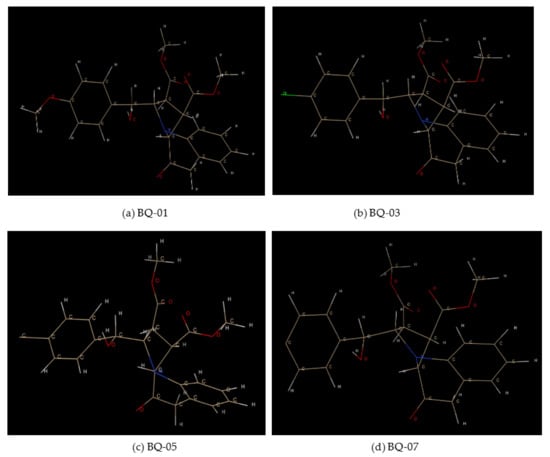
Figure 10.
The 3-dimensional structure of the ligand molecules visualized using Chimera: (a) BQ-01, (b) BQ-03, (c) BQ-05 and (d) BQ-07.
Next, comparative analyses were carried out to compare the binding interactions results from the synthesized ligands and the pre-existing drug against the C. albicans surface and SAP-3 receptors. The .sdf format file of the FDA approved drug file was taken from the online database PubChem. The mandatory .pdb 3D format file for the in silico docking analyses is essential; hence, the .sdf format of the drug was converted to .pdb format using OpenBabel software and visualized using Chimera software (Figure 11).
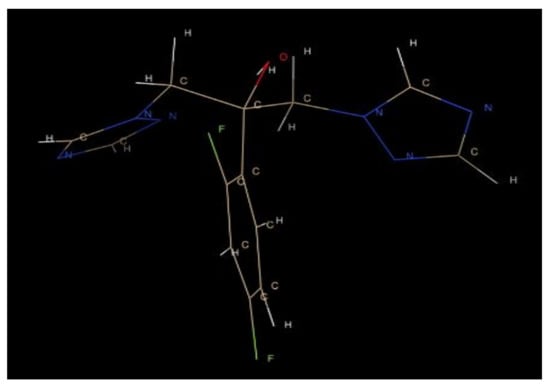
Figure 11.
The 3-dimensional structure of the drug (fluconazole) visualized using Chimera.
3.4. In Silico Molecular Interaction and Docking
The molecular interaction of the small molecules and their inhibitory potential against the C. albicans fungal proteins were studied using in silico molecular docking. Here, the molecular docking interactions were between the selected proteins from PDB against the optimized small molecules using PyRx software [105]. The respective macromolecule and the ligands were loaded onto the software and the active site residues were selected and grid box was generated around the selected amino acid residues. The docking results was carried out using a genetic algorithm. Moreover, the interaction achieved eight docking confirmations.
3.5. Conceptual DFT Reactivity Descriptors of the Molecules and Their Related Pharmacokinetics
The determination of the conformers of the molecules considered in the current study was performed by resorting to MarvinView 17.15, which is available from ChemAxon (http://www.chemaxon.com, accessed on 6 October 2020), by carrying out molecular mechanics calculations through the overall MMFF94 force field [75,76,77,78,79]. This was followed by a new geometry optimization and frequency calculation by means of the Density Functional Tight Binding (DFTBA) methodology [80]. This last step was required to verify the absence of imaginary frequencies to assess for the minimum stability of the optimized structures-in the energy landscape. The electronic properties and the chemical reactivity descriptors of the studied molecules involved the use of MN12SX/Def2TZVP/H2O [81,82,83] model chemistry on the previously optimized molecular structures because it has been shown that it allows the verification of the “Koopmans in DFT” (KID) procedure [69,84,85,86,87,88,89,90] with the aid of the Gaussian09 software [80] and the SMD solvation model [91].
With the aid of the KID technique and the finite difference approximation [69,84,85,86,87,88,89,90,95], the following expressions can be used to define the global reactivity descriptors [72,73,74,96,97]:
Electronegativity
Chemical Hardness
Global Electrophilicity
Electrodonating Power
Electroaccepting Power
Net Electrophilicity
where, as mentioned, and are the energies of the HOMO and LUMO, respectively.
After analyzing KID descriptors, The SMILES notation of all the studied compounds were fed into the online Molinspiration software from Molinspiration Cheminformatics (http://www.molinspiration.com, accessed on 6 October 2020) for the calculation of the molecular properties (∆G of Solvation, molecular weight, Log P, total polar surface area (TPSA), and molecular volume). The bioactivity scores were compared to those obtained using other software such as MolSoft from Molsoft L.L.C. (http://molsoft.com/mprop/, accessed on 6 October 2020) and ChemDoodle Version 9.02 from iChemLabs L.L.C. (http://www.chemdoodle.com), accessed on 6 October 2020.
4. Conclusions
The study shows novel pyrrolo[1,2-a]quinoline derivatives as putative drug targets of C. albicans. Here, in vitro screening of novel analogue derivatives against C. albicans fungal pathogen displayed inhibitory potentials of 75-fold for BQ-06, 07, and 08, and 37.5-fold for BQ-01, 03, and 05, followed by 18.75-fold for BQ-04, and 2.4-fold for BQ-02, in comparison to the standard antifungal fluconazole. Further, in silico molecular docking prediction of the ligand molecules BQ-01, 03, 05 and 07 compared to the drug alone exhibited strong hydrogen binding interactions with the regulating C. albicans protein β-glucan (3N9K), which demonstrates thermodynamically favorable conditions. Furthermore, these compound shows high binding energies ranging from −6.5 to −9.7 kcal/mol. However, based on the chemical structure, BQ-01, 03, 05 and 07 consist of methyl ester groups at the second and third positions compared to that of only one methyl ester at the third position, which is the case for BQ-02, 04, 06 and 08. Furthermore, BQ-01, 03, 05 and 07 possess a two-electron donor group, due to their effective interaction with C. albicans fungal proteins, which inhibits their growth compared to the single-electron donor groups present at the third positions of BQ-02, 04, 06 and 08. In addition, the determination of the chemical reactivity descriptors that arise from conceptual DFT allowed us to quantify the different values for the chemical reactivity of the studied molecules. Further, QSAR parameters, biological radars, exploration of possible targets and the pharmacokinetics of the systems suggested that compounds BQ-01, 03, 05 and 07 have good drug-like properties. In conclusion, the analyzed parameters can be useful in complementing the experimental data as the starting point for the development of new antifungal therapeutic drugs.
Author Contributions
Conceptualization, B.P., S.C. and K.K.M.-N.; methodology, S.C., V.U., C.S., S.P., S.P.K., M.C., J.O.-C., J.F., N.F.-H., A.I.B. and D.G.-M.; software, S.P, N.F.-H. and D.G.-M.; validation, S.C., K.K.M.-N., B.P. and D.G.-M.; formal analysis, S.C., K.N.V., G.B., Jayadev and B.P.N.; investigation, K.K.M.-N., V.U., S.C., C.S., M.C., M.M.M., J.O.-C., J.F., N.F.-H., A.I.B. and D.G.-M.; resources, K.N.V., A.A.A.-K., A.S. and A.M.E.; data curation, S.C., V.U., C.S., S.P., S.P.K. and M.M.M.; writing—original draft preparation, B.P., S.C., K.K.M.-N. and D.G.-M.; writing—review and editing, K.K.M.-N., M.C., G.B., Jayadev and B.P.N.; visualization, C.S., S.P. and S.P.K.; supervision, B.P., S.C. and K.K.M.-N.; project administration, B.P., S.C. and K.K.M.-N.; funding acquisition, B.P., S.C., K.K.M.-N., N.F.-H., D.G.-M., R.V., A.A.A.-K., A.S. and A.M.E. All authors have read and agreed to the published version of the manuscript.
Funding
The authors are grateful to the Deanship of Scientific Research, King Saud University, for funding through Vice Deanship of Scientific Research Chairs.
Institutional Review Board Statement
Not applicable.
Informed Consent Statement
Not applicable.
Acknowledgments
The authors acknowledge the Rani Channamma University, Belagavi, for providing laboratory facilities and JSS Academy of Higher Education and Research, Mysore, for carrying out antimicrobial activity and in silico molecular docking experiments. Further, DGM is a Visiting Professor at the Universitat de les Illes Balears from whose support is gratefully acknowledged. Moreover, N.F.-H. and D.G.-M. would like to thank CIMAV and CONACYT for partial support. The authors are grateful to the Deanship of Scientific Research, King Saud University, for funding through Vice Deanship of Scientific Research Chairs.
Conflicts of Interest
The authors declare no conflict of interest. The funders had no role in the design of the study; in the collection, analyses, or interpretation of data; in the writing of the manuscript, or in the decision to publish the results.
Sample Availability
Aliquots of samples are available from the authors.
References
- Gudlaugsson, O.; Gillespie, S.; Lee, K.; Berg, J.V.; Hu, J.; Messer, S.; Herwaldt, L.; Pfaller, M.; Diekema, D. Attributable mortality of nosocomial candidemia, revisited. Clin. Infect. Dis. 2003, 37, 1172–1177. [Google Scholar] [CrossRef]
- Antinori, S.; Milazzo, L.; Sollima, S.; Galli, M.; Corbellino, M. Candidemia and invasive candidiasis in adults: A narrative review. Eur. J. Intern. Med. 2016, 34, 21–28. [Google Scholar] [CrossRef]
- Sudbery, P.E. Growth of Candida albicans hyphae. Nat. Rev. Genet. 2011, 9, 737–748. [Google Scholar] [CrossRef]
- Gow, N.A.R.; Van De Veerdonk, F.L.; Brown, A.J.P.; Netea, M.G. Candida albicans morphogenesis and host defence: Discriminating invasion from colonization. Nat. Rev. Genet. 2011, 10, 112–122. [Google Scholar] [CrossRef] [PubMed]
- Lu, Y.; Su, C.; Liu, H. Candida albicans hyphal initiation and elongation. Trends Microbiol. 2014, 22, 707–714. [Google Scholar] [CrossRef]
- Gow, N.A.R.; Yadav, B. Microbe Profile: Candida albicans: A shape-changing, opportunistic pathogenic fungus of humans. Microbiology 2017, 163, 1145–1147. [Google Scholar] [CrossRef] [PubMed]
- Sardi, J.C.O.; Scorzoni, L.; Bernardi, T.; Fusco-Almeida, A.M.; Giannini, M.J.S.M. Candida species: Current epidemiology, pathogenicity, biofilm formation, natural antifungal products and new therapeutic options. J. Med. Microbiol. 2013, 62, 10–24. [Google Scholar] [CrossRef]
- Dantas, A.D.S.; Lee, K.K.; Raziunaite, I.; Schaefer, K.; Wagener, J.; Yadav, B.; Gow, N.A. Cell biology of Candida albicans–host interactions. Curr. Opin. Microbiol. 2016, 34, 111–118. [Google Scholar] [CrossRef]
- Sanguinetti, M.; Posteraro, B.; Lass-Flörl, C. Antifungal drug resistance among Candidaspecies: Mechanisms and clinical impact. Mycoses 2015, 58, 2–13. [Google Scholar] [CrossRef] [PubMed]
- Cui, J.; Ren, B.; Tong, Y.; Dai, H.; Zhang, L. Synergistic combinations of antifungals and anti-virulence agents to fight againstCandida albicans. Virulence 2015, 6, 362–371. [Google Scholar] [CrossRef] [PubMed]
- Perfect, J.R. The antifungal pipeline: A reality check. Nat. Rev. Drug Discov. 2017, 16, 603–616. [Google Scholar] [CrossRef] [PubMed]
- Qin, Y.; Zhang, L.; Xu, Z.; Zhang, J.; Jiang, Y.-Y.; Cao, Y.; Yan, T. Innate immune cell response uponCandida albicansinfection. Virulence 2016, 7, 512–526. [Google Scholar] [CrossRef]
- Silva, D.R.; Sardi, J.D.C.O.; Freires, I.A.; Silva, A.C.B.; Rosalen, P.L. In silico approaches for screening molecular targets in Candida albicans: A proteomic insight into drug discovery and development. Eur. J. Pharm. 2019, 842, 64–69. [Google Scholar] [CrossRef]
- Howard, K.C.; Dennis, E.K.; Watt, D.S.; Garneau-Tsodikova, S. A comprehensive overview of the medicinal chemistry of antifungal drugs: Perspectives and promise. Chem. Soc. Rev. 2020, 49, 2426–2480. [Google Scholar] [CrossRef]
- Whaley, S.G.; Berkow, E.L.; Rybak, J.M.; Nishimoto, A.T.; Barker, K.S.; Rogers, P.D. Azole antifungal resistance in candida albicans and emerging non-albicans candida species. Front. Microbiol. 2017, 7, 2173. [Google Scholar] [CrossRef] [PubMed]
- Venugopala, K.N.; Chandrashekharappa, S.; Alwassil, O.I.; Harsha, S.; Mlisana, K.; Odhav, B.; Pillay, M.; Bhandary, S.; Kandeel, M.; Mahomoodally, F.M.; et al. Synthesis and structural elucidation of novel benzothiazole derivatives as anti-tubercular agents: In-silico screening for possible target identification. Med. Chem. 2019, 15, 311–326. [Google Scholar] [CrossRef] [PubMed]
- Siddesh, M.B.; Padmashali, B.; Thriveni, K.S.; Sandeep, C. Synthesis of thiophene-linked pyrimidopyrimidines as pharmaceutical leads. J. Chem. Sci. 2014, 126, 821–826. [Google Scholar] [CrossRef]
- Thriveni, K.S.; Padmashali, B.; Siddesh, M.B.; Sandeep, C. Synthesis of pyrimidine incorporated piperazine derivatives and their antimicrobial activity. Indian J. Pharm. Sci. 2014, 76, 332–338. [Google Scholar]
- Nagesh, K.B.; Padmashali, C.; Sandeep, T.C.M.; Yuvaraj, M.B.; Mallikarjuna, S.M. Synthesis and antimicrobial AC-tivity of benzothiophene substituted coumarins, pyrimidines and pyrazole as new scaffold. Int. J. Pharm. Sci. Rev. Res. 2014, 28, 6–10. [Google Scholar]
- Nagesh, K.B.; Padmashali, C.; Sandeep, T.E.; Lokesh, M. Synthesis and characterization of novel benzothiophene substituted oxadiazole derivatives and their antimicrobial activity. Der Pharm. Chem. 2015, 7, 129–136. [Google Scholar]
- Venugopala, K.N.; Chandrashekharappa, S.; Bhandary, S.; Chopra, D.; Khedr, M.A.; Aldhubiab, B.E.; Attimarad, M.; Odhav, B. Efficient synthesis and characterization of novel substituted 3-benzoylindolizine analogues via the cyclization of aromatic cycloimmoniumylides with electrondeficient alkenes. Curr. Org. Synth. 2018, 15, 388–395. [Google Scholar] [CrossRef]
- Chandrashekharappa, S.; Venugopala, K.N.; Nayak, S.K.; Gleiser, R.M.; García, D.A.; Kumalo, H.M.; Kulkarni, R.S.; Mahomoodally, F.M.; Venugopala, R.; Mohan, M.K.; et al. One-pot microwave assisted synthesis and structural elucidation of novel ethyl 3-substituted-7-methylindolizine-1-carboxylates with larvicidal activity against Anopheles arabiensis. J. Mol. Struct. 2018, 1156, 377–384. [Google Scholar] [CrossRef]
- Chandrashekharappa, S.; Venugopala, K.N.; Tratrat, C.; Mahomoodally, F.M.; Al-Dhubiab, B.E.; Haroun, M.; Venugopala, R.; Mohan, M.K.; Kulkarni, R.S.; Attimarad, M.V.; et al. Efficient synthesis and characterization of novel indolizines: Exploration of in vitro COX-2 inhibitory activity and molecular modelling studies. New J. Chem. 2018, 42, 4893–4901. [Google Scholar] [CrossRef]
- Mallikarjuna, S.M.; Padmashali, M.S.M.B.; Chandrashekharappa, S.; Sandeep, C. Synthesis, anticancer and antituberculosis studies for [1-(4-chlorophenyl) Cyclopropyl] (Piperazine-yl) Methanone derivates. Int. J. Pharm. Pharm. Sci. 2014, 6, 423–427. [Google Scholar]
- Mallikarjuna, S.M.; Chandrashekharappa, S.P.B. Acid amine coupling of (1h-indole-6-yl) Ppiperazin-1-yl) Methanone with substituted acids using hatu coupling reagent and their antimicrobial and antioxidant activity. Int. J. Pharm. Sci. Res. 2017, 8, 2879–2885. [Google Scholar] [CrossRef]
- Sandeep, C.; Padmashali, B.; Kulkarni, R.S.; Mallikarjuna, S.M.; Siddesh, M.B.; Nagesh, H.K.; Thriveni, K.S. Synthesis of substituted 5-acetyl-3- benzoylindolizine-1-carboxylate from substituted 2-acetyl pyridinium bromides. Heterocycl. Lett. 2014, 4, 371–376. [Google Scholar]
- Sandeep, C.; Venugopala, K.N.; Khedr, M.A.; Padmashali, B.; Kulkarni, R.S.; Venugopala, R.; Odhav, B. Design and synthesis of novel indolizine analogues as cox-2 inhibitors: Computational perspective and in vitro screening. Indian J. Pharm. Educ. Res. 2017, 51, 452–460. [Google Scholar] [CrossRef]
- Sandeep, C.; Padmashali, B.; Venugopala, K.N.; Kulkarni, R.S.; Venugopala, R.; Odhav, B. Synthesis and characterization of ethyl 7-acetyl-2-substituted 3-(Substituted benzoyl) Indolizine-1-carboxylates for in vitro anticancer activity. Asian J. Chem. 2016, 28, 1043–1048. [Google Scholar] [CrossRef]
- Sandeep, C.; Venugopala, K.N.; Gleiser, R.M.; Chetram, A.; Padmashali, B.; Kulkarni, R.S.; Venugopala, R.; Odhav, B. Greener synthesis of indolizine analogues using water as a base and solvent: Study for larvicidal activity againstAnopheles arabiensis. Chem. Biol. Drug Des. 2016, 88, 899–904. [Google Scholar] [CrossRef]
- Venugopala, K.N.; Al-Attraqchi, O.H.; Girish, M.B.; Chandrashekharappa, S.; Alwassil, O.I.; Odhav, B.; Tratrat, C.; Nayak, S.K.; Morsy, M.A.; Aldhubiab, B.E.; et al. Novel series of methyl 3-(Substituted benzoyl)-7-substituted-2-phenylindolizine-1-carboxylates as promising anti-inflammatory agents: Molecular modeling studies. Biomolecules 2019, 9, 661. [Google Scholar] [CrossRef] [PubMed]
- Venugopala, K.N.; Tratrat, C.; Haroun, M.; Odhav, B.; Chandrashekharappa, S.; Attimarad, M.; Sreeharsha, N.; Nair, A.; Pottathil, S.; Venugopala, R.; et al. Anti-tubercular potency and computationallyassessed drug-likeness and toxicology of diversely substituted indolizines. Indian J. Pharm. Educ. Res. 2019, 53, 545–552. [Google Scholar] [CrossRef]
- Venugopala, K.N.; Chandrashekharappa, S.; Sreeharsha, N.; Morsy, M.A.; Pottathil, S.; Venugopala, R.; Odhav, B.; Mlisana, K.; Pillay, M.; Abdallah, H.H.; et al. Computational, crystallographic studies, cytotoxicity and anti-tubercular activity of substituted 7-methoxy-indolizine analogues. PLoS ONE 2019, 14, e0217270. [Google Scholar] [CrossRef] [PubMed]
- Venugopala, K.N.; Tratrat, C.; Nair, A.B.; Sreeharsha, N.; Venugopala, R.; Chandrashekharappa, S.; Alwassil, O.I.; Odhav, B.; Pillay, M.; Mahomoodally, F.M.; et al. Anti-tubercular activity of substituted 7-methyl and 7-formylindolizines and in silico study for prospective molecular target identification. Antibiotics 2019, 8, 247. [Google Scholar] [CrossRef] [PubMed]
- Venugopala, K.N.; Tratrat, C.; Pillay, M.; Chandrashekharappa, S.; Al-Attraqchi, O.H.A.E.; Aldhubiab, B.; Attimarad, M.I.; Alwassil, O.; Nair, A.B.; Sreeharsha, N.; et al. In silico design and synthesis of tetrahydropyrimidinones and tetrahydropyrimidinethiones as potential thymidylate kinase inhibitors exerting anti-TB activity against mycobacterium tuberculosis. Drug Des. Dev. Ther. 2020, ume 14, 1027–1039. [Google Scholar] [CrossRef]
- Venugopala, K.N.; Uppar, V.; Chandrashekharappa, S.; Abdallah, H.H.; Pillay, M.; Deb, P.K.; Morsy, M.A.; Aldhubiab, B.E.; Attimarad, M.; Nair, A.B.; et al. Cytotoxicity and Antimycobacterial Properties of Pyrrolo[1,2-a]quinoline Derivatives: Molecular Target Identification and Molecular Docking Studies. Antibiotics 2020, 9, 233. [Google Scholar] [CrossRef] [PubMed]
- Hasija, A.; Bhandary, S.; Venugopala, K.N.; Chandrashekharappa, S.; Chopra, D. Structural investigation of methyl 3-(4-fluorobenzoyl)-7-methyl-2-phenylindolizine-1-carboxylate, an inhibitory drug towards Mycobacterium tuberculosis. Acta Cryst. Sect. E Cryst. Commun. 2020, 76, 567–571. [Google Scholar] [CrossRef] [PubMed]
- Khedr, M.A.; Pillay, M.; Chandrashekharappa, S.; Chopra, D.; Aldhubiab, B.E.; Attimarad, M.; Alwassil, O.I.; Mlisana, K.; Odhav, B.; Venugopala, K.N. Molecular modeling studies and anti-TB activity of trisubstituted indolizine analogues; molecular docking and dynamic inputs. J. Biomol. Struct. Dyn. 2018, 36, 2163–2178. [Google Scholar] [CrossRef] [PubMed]
- Sandeep, C.; Venugopala, K.N.; Khedr, M.A.; Attimarad, M.; Padmashali, B.; Kulkarni, R.S.; Venugopala, R.; Odhav, B. Review on chemistry of natural and synthetic indolizines with their chemical and pharmacological properties. J. Basic Clin. Pharm. 2017, 8, 49–60. [Google Scholar]
- Chandrashekharappa, S.; Venugopala, K.N.; Venugopala, R.; Padmashali, B. Qualitative anti-tubercular activity of synthetic ethyl 7-acetyl2-substituted-3-(4-substituted benzoyl) indolizine-1-carboxylate analogues. J. Appl. Pharm. Sci. 2019, 9, 124–128. [Google Scholar] [CrossRef]
- Sandeep, C.; Padmashali, B.; Kulkarni, R.S. Efficient synthesis of indolizines and new imidazo[1,2-a]pyridines via the expected cyclization of aromatic cycloimmonium ylides with electron deficient alkynes and ethyl cyanoformate. Tetrahedron Lett. 2013, 54, 6411–6414. [Google Scholar] [CrossRef]
- Sandeep, C.; Basavaraj, P.; Rashmi, S.K. Synthesis of isomeric subtituted 6-acetyl-3-benzoylindolizine- 1-carboxylate and 8-acetyl-3-benzoylindolizine-1-carboxylate from subtituteded 3-acetyl pyri-dinium bromides and their antimicrobial activity. J. Appl. Chem. 2013, 2, 1049–1052. [Google Scholar]
- Østby, O.B.; Dalhus, B.; Gundersen, L.-L.; Rise, F.; Bast, A.; Haenen, G.R.M.M. Synthesis of 1-substituted 7-cyano-2,3-diphenylindolizines and evaluation of antioxidant properties. Eur. J. Org. Chem. 2000, 2000, 3763–3770. [Google Scholar] [CrossRef]
- Baidya, M.; Kumar, J.; Srivastava, A.K.; Jyothi, C.; Gupta, A.; Das, A.K. Synthesis and pharmacological screening of some in-dolizinamido glutamine amino acid derivatives. Indian J. Heterocycl. Chem. 2004, 14, 81–82. [Google Scholar]
- Uppar, V.; Mudnakudu-Nagaraju, K.K.; Basarikatti, A.I.; Chougala, M.; Chandrashekharappa, S.; Mohan, M.K.; Banuprakash, G.; Venugopala, K.N.; Ningegowda, R.; Padmashali, B. Microwave induced synthesis, and pharmacological properties of novel 1-benzoyl-4-bromopyrrolo[1,2-a]quinoline-3-carboxylate analogues. Chem. Data Collect. 2020, 25, 100316. [Google Scholar] [CrossRef]
- Das, A.K.; Mukherjee, I. Synthesis and antimicrobial activity of mannich bases of indolizine analogues. Orient. J. Chem. 2006, 22, 339–342. [Google Scholar]
- Das, A.K.; Mukherjee, I. Synthesis and evaluation of some 3-benzoylindolizine-1-carboxamides as possible anti-inflammatory and analgesic agents. Orient. J. Chem. 2006, 22, 415–420. [Google Scholar]
- Kallay, K.R.; Doerge, R.F. P-substituted 1,2-diphenylindolizines as anti-inflammatory agents. J. Pharm. Sci. 1972, 61, 949–951. [Google Scholar] [CrossRef] [PubMed]
- James, D.A.; Koya, K.; Li, H.; Liang, G.; Xia, Z.; Ying, W.; Wu, Y.; Sun, L. Indole- and indolizine-glyoxylamides displaying cytotoxicity against multidrug resistant cancer cell lines. Bioorg. Med. Chem. Lett. 2008, 18, 1784–1787. [Google Scholar] [CrossRef] [PubMed]
- Morita, K.; Yamamoto, I.H. Synthesis of indolizine derivatives. Biochem. Pharmacol. 1973, 22, 111–115. [Google Scholar]
- Lingala, S.; Nerella, R.; Cherukupally, R.; Das, A.K. Synthesis and comparative anti-tubercular activity of indolizine deriva-tives of isoniazid/Pyrazinamide/Ethionamide. Int. J. Pharm. Sci. Rev. Res. 2011, 6, 128–131. [Google Scholar]
- Liu, Y.; Zhang, Y.; Shen, Y.-M.; Hu, H.-W.; Xu, J.-H. Regioselective synthesis of 3-acylindolizines and benzo- analogues via 1,3-dipolar cycloadditions of N-ylides with maleic anhydride. Org. Biomol. Chem. 2010, 8, 2449–2456. [Google Scholar] [CrossRef]
- Sharma, V.; Kumar, V. Indolizine: A biologically active moiety. Med. Chem. Res. 2014, 23, 3593–3606. [Google Scholar] [CrossRef]
- Gómez, C.M.M.; Kouznetsov, V.V.; Sortino, M.A.; Álvarez, S.L.; Zacchino, S.A. In vitro antifungal activity of polyfunctionalized 2-(hetero)arylquinolines prepared through imino Diels–Alder reactions. Bioorg. Med. Chem. 2008, 16, 7908–7920. [Google Scholar] [CrossRef] [PubMed]
- Vemula, V.R.; Vurukonda, S.; Bairi, C.K. Indolizine derivatives: Recent advances and potential pharmacological activities. Int. J. Pharm. Sci. Rev. Res. 2011, 11, 159–163. [Google Scholar]
- Uppar, V.; Chandrashekharappa, S.; Basarikatti, A.I.; Banuprakash, G.; Mohan, M.; Chougala, M.; Mudnakudu-Nagaraju, K.K.; Ningegowda, R.; Padmashali, B. Synthesis, antibacterial, and antioxidant studies of 7-amino-3-(4-fluorobenzoyl)indolizine-1-carboxylate derivatives. J. Appl. Pharm. Sci. 2020, 10, 77–85. [Google Scholar] [CrossRef]
- Uppar, V.; Chandrashekharappa, S.; Venugopala, K.N.; Deb, P.K.; Kar, S.; Alwassil, O.I.; Gleiser, R.M.; Garcia, D.; Odhav, B.; Mohan, M.K.; et al. Synthesis and characterization of pyrrolo[1,2-a]quinoline derivatives for their larvicidal activity against Anopheles arabiensis. Struct. Chem. 2020, 31, 1533–1543. [Google Scholar] [CrossRef]
- Dillard, R.D.; Pavey, D.E.; Benslay, D.N. Synthesis and antiinflammatory activity of some 2,2-dimethyl-1,2-dihydroquinolines. J. Med. Chem. 1973, 16, 251–253. [Google Scholar] [CrossRef]
- Sechi, M.; Rizzi, G.; Bacchi, A.; Carcelli, M.; Rogolino, D.; Pala, N.; Sanchez, T.W.; Taheri, L.; Dayam, R.; Neamati, N. Design and synthesis of novel dihydroquinoline-3-carboxylic acids as HIV-1 integrase inhibitors. Bioorg. Med. Chem. 2009, 17, 2925–2935. [Google Scholar] [CrossRef]
- Dubé, D.; Blouin, M.; Brideau, C.; Chan, C.-C.; Desmarais, S.; Ethier, D.; Falgueyret, J.-P.; Friesen, R.W.; Girard, M.; Girard, Y.; et al. Quinolines as potent 5-lipoxygenase inhibitors: Synthesis and biological profile of L-746,530. Bioorg. Med. Chem. Lett. 1998, 8, 1255–1260. [Google Scholar] [CrossRef]
- Testa, M.L.; Lamartina, L.; Mingoia, F. A new entry to the substituted pyrrolo[3,2-c]quinoline derivatives of biological interest by intramolecular heteroannulation of internal imines. Tetrahedron 2004, 60, 5873–5880. [Google Scholar] [CrossRef]
- Martins, C.; Carreiras, M.C.; Leon, R.; Ríos, C.D.L.; Bartolini, M.; Andrisano, V.; Iriepa, I.; Moraleda, I.; Gálvez, E.; Garcia, M.; et al. Synthesis and biological assessment of diversely substituted furo[2,3-b]quinolin-4-amine and pyrrolo[2,3-b]quinolin-4-amine derivatives, as novel tacrine analogues. Eur. J. Med. Chem. 2011, 46, 6119–6130. [Google Scholar] [CrossRef] [PubMed]
- Guha, R.; Bender, A. Computational Approaches in Cheminformatics and Bioinformatics; Wiley: Hoboken, NJ, USA, 2012. [Google Scholar]
- Chakraborty, A.; Pan, S.; Chattaraj, P.K. Biological activity and toxicity: A conceptual dft approach. In Structure and Bonding; Springer International Publishing: Berlin/Heidelberg, Germany, 2013; pp. 143–179. [Google Scholar]
- Pan, S.; Gupta, A.; Subramanian, V.; Chattaraj, P.K. Quantitative structure-activity/Property/Toxicity relationships through conceptual density functional theory-based reactivity descriptors. In Sustainable Nanosystems Development, Properties, and Applications; IGI Global: Hershey, PA, USA, 2015; pp. 123–179. [Google Scholar]
- Pan, S.A.; Gupta, D.; Roy, R.; Sharma, V.; Subramanian, A.; Mitra, P.; Chattaraj., P. Application of conceptual density functional theory in developing qsar models and their usefulness in the prediction of biological activity and toxicity of molecules. In Chemometrics Applications and Research; Apple Academic Press: Palm Bay, FL, USA, 2016; pp. 183–214. [Google Scholar]
- Kon’e, M.G.-R.; N’dri, J.S.; Kodjo, C.G.; Kablan, A.L.C.; Ouattara, L.; Ouattara, O. Combining of dft and qsar results to predict the antibacterial activity of a series of azetidinones derived from dapsone as inhibitors of bacillus subtilis and pseudomonas aeruginosa. SDRP J. Comp. Chem. Mol. Model. 2018, 2, 1–8. [Google Scholar]
- Zermeño-Macías, M.D.L.Á.; González-Chávez, M.M.; Méndez, F.; González-Chávez, R.; Richaud, A. Theoretical reactivity study of indol-4-ones and their correlation with antifungal activity. Molecules 2017, 22, 427. [Google Scholar] [CrossRef] [PubMed]
- Frau, J.; Muñoz, F.; Glossman-Mitnik, D. A molecular electron density theory study of the chemical reactivity of cis- and trans-resveratrol. Molecules 2016, 21, 1650. [Google Scholar] [CrossRef]
- Flores-Holguín, N.; Frau, J.; Glossman-Mitnik, D. Computational peptidology assisted by conceptual density functional theory for the study of five new antifungal tripeptides. ACS Omega 2019, 4, 12555–12560. [Google Scholar] [CrossRef]
- Rajpoot, M.; Bhattacharyya, R.; Sharma, A.K.; Gupta, G.K.; Kumar, V. 2. Drug designing in novel drug discovery: Trends, scope and relevance. In Chemical Drug Design; Springer: Berlin, Germany, 2016; pp. 15–30. [Google Scholar]
- Gore, M.; Jagtap, U.B. Computational Drug Discovery and Design; Springer Science Business Media, LLC.: New York, NY, USA, 2018. [Google Scholar]
- Parr, R.; Yang, W. Density-Functional Theory of Atoms and Molecules; Oxford University Press: New York, NY, USA, 1989. [Google Scholar]
- Chermette, H. Chemical reactivity indexes in density functional theory. J. Comput. Chem. 1999, 20, 129–154. [Google Scholar] [CrossRef]
- Geerlings, P.; De Proft, F.; Langenaeker, W. Conceptual density functional theory. Chem. Rev. 2003, 103, 1793–1873. [Google Scholar] [CrossRef]
- Halgren, T.A. Merck molecular force field: I. Basis, form, scope, parameterization, and performance of mmff94. J. Comput. Chem. 1996, 17, 490–519. [Google Scholar] [CrossRef]
- Halgren, T.A. Merck molecular force field. II. Mmff94 van der waals and electrostatic parameters for intermolecular inter-actions. J. Comput. Chem. 1996, 17, 520–552. [Google Scholar] [CrossRef]
- Halgren, T.A. MMFF VI. MMFF94s Option for energy minimization studies. J. Comput. Chem. 1999, 20, 720–729. [Google Scholar] [CrossRef]
- Halgren, T.A.; Nachbar, R.B. Merck molecular force field. IV. Conformational energies and geometries for MMFF94. J. Comput. Chem. 1996, 17, 587–615. [Google Scholar] [CrossRef]
- Halgren, T.A. Merck molecular force field. V. Extension of MMFF94 using experimental data, additional computational data, and empirical rules. J. Comput. Chem. 1996, 17, 616–641. [Google Scholar] [CrossRef]
- Frisch, M.J.; Trucks, G.W.; Schlegel, G.E.; Scuseria, M.A.; Robb, J.R.; Cheeseman, G.; Scalmani, V.; Barone, B.; Mennucci, G.A.; Petersson, H.; et al. Gaussian 09 Revision E.01; Gaussian Inc.: Wallingford, CT, USA, 2016. [Google Scholar]
- Peverati, R.; Truhlar, D.G. Screened-exchange density functionals with broad accuracy for chemistry and solid-state physics. Phys. Chem. Chem. Phys. 2012, 14, 16187–16191. [Google Scholar] [CrossRef] [PubMed]
- Weigend, F.; Ahlrichs, R. Balanced basis sets of split valence, triple zeta valence and quadruple zeta valence quality for H to Rn: Design and assessment of accuracy. Phys. Chem. Chem. Phys. 2005, 7, 3297–3305. [Google Scholar] [CrossRef] [PubMed]
- Weigend, F. Accurate Coulomb-fitting basis sets for H to Rn. Phys. Chem. Chem. Phys. 2006, 8, 1057–1065. [Google Scholar] [CrossRef] [PubMed]
- Flores-Holguín, N.; Frau, J.; Glossman-Mitnik, D. Conceptual dft as a helpful chemoinformatics tool for the study of the cla-vanin family of antimicrobial marine peptides. In Density Functional Theory Calculations; IntechOpen: Rijeka, Croatia, 2019; pp. 1–11. [Google Scholar]
- Frau, J.; Glossman-Mitnik, D. Molecular reactivity and absorption properties of melanoidin blue-g1 through conceptual dft. Molecules 2018, 23, 559. [Google Scholar] [CrossRef]
- Frau, J.; Glossman-Mitnik, D. Conceptual dft study of the local chemical reactivity of the dilysyldipyrrolones a and b in-termediate melanoidins. Chem. Acc. 2018, 137, 1210. [Google Scholar] [CrossRef]
- Frau, J.; Glossman-Mitnik, D. Conceptual dft study of the local chemical reactivity of the colored bisarg melanoidin and its protonated derivative. Front. Chem. 2018, 6, 136. [Google Scholar] [CrossRef]
- Frau, J.; Glossman-Mitnik, D. Computational study of the chemical reactivity of the Blue-M1 intermediate melanoidin. Comput. Chem. 2018, 1134, 22–29. [Google Scholar] [CrossRef]
- Frau, J.; Glossman-Mitnik, D. Chemical reactivity theory applied to the calculation of the local reactivity descriptors of a colored maillard reaction product. Chem. Sci. Int. J. 2018, 22, 1–14. [Google Scholar] [CrossRef]
- Frau, J.; Glossman-Mitnik, D. Blue M2: An intermediate melanoidin studied via conceptual DFT. J. Mol. Model. 2018, 24, 138. [Google Scholar] [CrossRef]
- Marenich, A.V.; Cramer, C.J.; Truhlar, D.G. Universal solvation model based on solute electron density and on a continuum model of the solvent defined by the bulk dielectric constant and atomic surface tensions. J. Phys. Chem. B 2009, 113, 6378–6396. [Google Scholar] [CrossRef] [PubMed]
- Flores-Holguín, N.; Frau, J.; Glossman-Mitnik, D. A fast and simple evaluation of the chemical reactivity properties of the Pristinamycin family of antimicrobial peptides. Chem. Phys. Lett. 2020, 739, 137021. [Google Scholar] [CrossRef]
- Flores-Holguín, N.; Frau, J.; Glossman-Mitnik, D. Conceptual dft- based computational peptidology of marine natural compounds: Dis- codermins a–h. Molecules 2020, 25, 4158. [Google Scholar] [CrossRef]
- Flores-Holguín, N.; Frau, J.; Glossman-Mitnik, D. Virtual screening of marine natural compounds by means of chemoinformatics and cdft-based computational peptidology. Mar. Drugs 2020, 18, 478. [Google Scholar] [CrossRef] [PubMed]
- Frau, J.; Glossman-Mitnik, D. Molecular reactivity of some maillard reaction products studied through conceptual DFT. Contemp. Chem. 2018, 1, 1–14. [Google Scholar]
- Gázquez, J.; Cedillo, A.; Vela, A. Electrodonating and electroaccepting powers. J. Phys. Chem. 2007, 111, 1966–1970. [Google Scholar]
- Chattaraj, P.K.; Chakraborty, A.; Giri, S. Net electrophilicity. J. Phys. Chem. A 2009, 113, 10068–10074. [Google Scholar] [CrossRef]
- Jaramillo, P.; Domingo, L.R.; Chamorro, E.; Pérez, P. A further exploration of a nucleophilicity index based on the gas-phase ionization potentials. J. Mol. Struct. 2008, 865, 68–72. [Google Scholar] [CrossRef]
- Daina, A.; Michielin, O.; Zoete, V. SwissTargetPrediction: Updated data and new features for efficient prediction of protein targets of small molecules. Nucleic Acids Res. 2019, 47, W357–W364. [Google Scholar] [CrossRef]
- Daina, A.; Michielin, O.; Zoete, V. Swissadme: A free web tool to evaluate pharmacokinetics, drug-likeness and medicinal chemistry friendliness of small molecules. Sci. Rep. 2017, 7, 42717. [Google Scholar] [CrossRef] [PubMed]
- Prasad, A.; Govindaraju, S.; Sushma, P.; Jain, A.S.; Chandan, D.; Prasad, M.N.N.; Kollur, S.P.; Srinivasa, C.; Shivamallu, C. Helicobacter pylori infection: A bioinformatic approach. Int. J. Pharm. Sci. Res. 2020, 11, 5469–5483. [Google Scholar]
- O’Boyle, N.M.; Banck, M.A.; James, C.; Morley, C.; Vandermeersch, T.; Hutchison, G.R. Open Babel: An open chemical toolbox. J. Cheminform. 2011, 3, 33. [Google Scholar] [CrossRef]
- Jain, A.S.; Sushma, P.; Chandan, D.; Beelagi, M.S.; Shashank, P.; Chandan, S.; Prasad, A.; Syed, A.; Marraiki, N.; Prasad, K.S. Effect of flavonoids having anti-inflammatory and antiviral properties on the spike glycoprotein of SARS-CoV-2: An In silico Approach. Saudi J. Biol. Sci. 2020, 28, 1040–1051. [Google Scholar] [CrossRef]
- Prasad, S.K.; Sushma, P.; Chandan, S.; Kollur, S.P.; Syed, A.; Castro, J.O.; Frau, J.; Holguín, N.F.; Mitnik, D.G. Evaluating annona muricata acetogenins as possible anti-sars-cov-2 agents through in silico analysis and theoretical chemistry approaches. Front. Chem. 2021, 8, 624716. [Google Scholar] [CrossRef] [PubMed]
- Dallakyan, S.; Olson, A.J. Small-molecule library screening by docking with PyRx. In NMR-Based Metabolomics; Springer Science and Business Media, LLC.: Berlin/Heidelberg, Germany, 2015; Volume 1263, pp. 243–250. [Google Scholar]
Publisher’s Note: MDPI stays neutral with regard to jurisdictional claims in published maps and institutional affiliations. |
© 2021 by the authors. Licensee MDPI, Basel, Switzerland. This article is an open access article distributed under the terms and conditions of the Creative Commons Attribution (CC BY) license (http://creativecommons.org/licenses/by/4.0/).